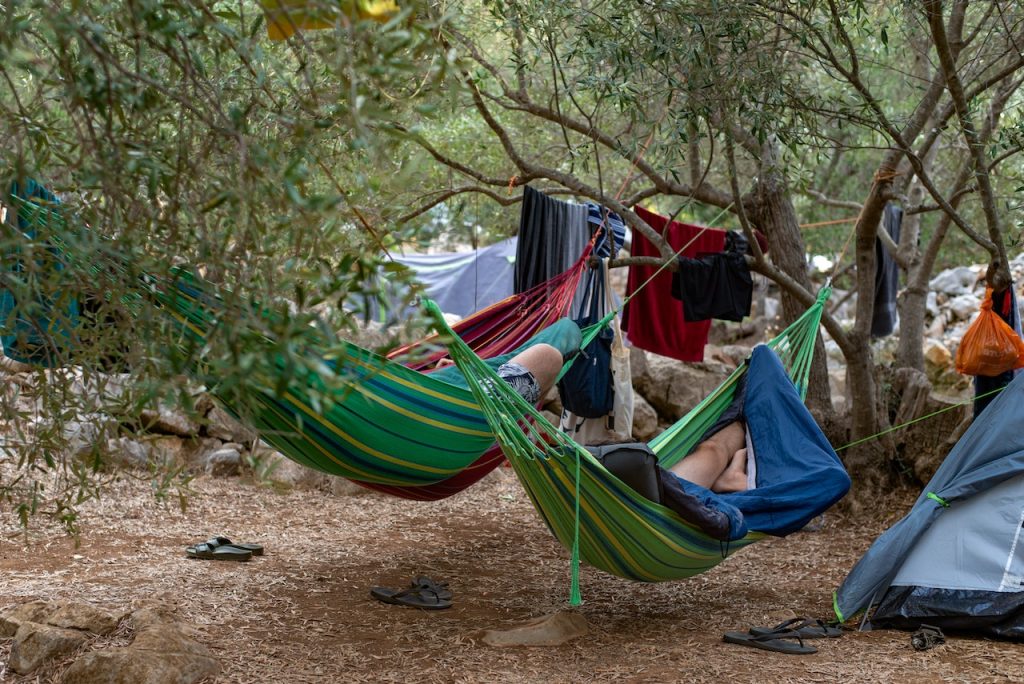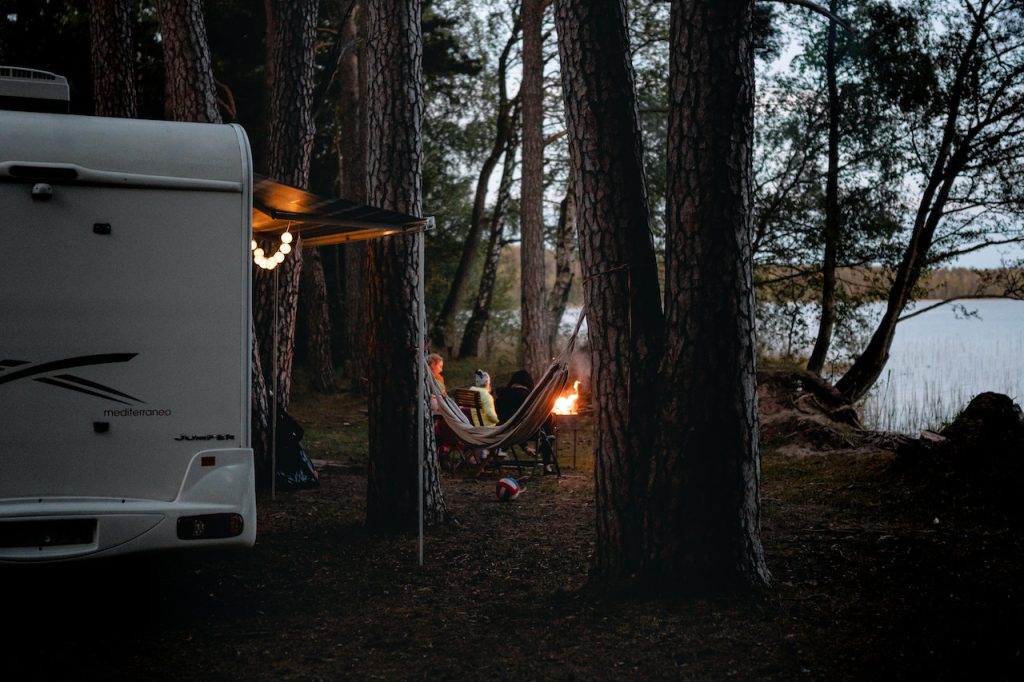Hammocks are a popular choice for camping, as they provide a comfortable and portable way to sleep while on the go. Making your camping hammock can be a fun and rewarding DIY project, and it allows you to customize the size, fabric, and suspension system to meet your specific needs and preferences. This article will guide you on how to make a camping hammock and its pros and cons.
How to make a Camping Hammock- Materials and Tools
Table of Contents
ToggleTo make a camping hammock, you’ll need the following materials and tools:
Fabric:
Choose a solid and durable fabric, such as ripstop nylon or water-resistant polyester. You’ll need enough fabric to create a long, wide loop to fit your body comfortably.
Thread:
Sew the ends of the fabric together with a strong, durable thread like nylon or polyester, and attach the carabiners.
Carabiners:
Carabiners are metal loops with a spring-loaded gate that you can open and close, and you can use them to attach the hammock to the suspension system. Use carabiners rated for the weight you will be connecting to them.
Suspension system:
There are many options for suspending a hammock, including straps, cords, and webbing. Choose a suspension system appropriate for the environment you’ll be camping in (e.g., trees, rocks, posts) that can support the weight of your hammock and any gear you’ll be storing.
How to Make a Camping Hammock

To make a camping hammock, follow these steps:
Cut the fabric to the desired size.
Measure and mark the material, then use a sharp pair of scissors to cut it to the appropriate length and width. Consider using a water-resistant or ripstop fabric for added durability.
Stich the ends of the fabric together to create a loop.
Fold the fabric in half and align the edges, then use a solid and durable thread and a zigzag stitch to sew the ends together. Make sure to reinforce the stitches and tie off the line securely. Attach the carabiners. Measure and mark where the carabiners will be attached, then sew them onto the fabric using a reinforcing stitch. Use a solid and durable thread and securely tie off the line.
Assemble the suspension system.
Choose a suspension system appropriate for your camping environment, and follow the instructions for attaching it to the hammock. Make sure to attach the suspension system securely to the carabiners and test the hammock for strength and stability before using it.
Test and adjust the hammock.
Before using the hammock, test it for strength and stability. Make adjustments to the suspension system to ensure a secure and comfortable hang.
What’s the best place for a camping hammock?
The ideal location for a camping hammock may vary based on various factors, including individual preferences, the specific type of hammock being used, and the surrounding camping environment. Here are a few things to consider:
- Find two sturdy trees that are the proper distance apart. The trees should be 12-15 feet apart and strong enough to support your and the hammock’s weight. Avoid trees with dead branches or signs of decay.
- Look for a level spot. Your hammock will be most comfortable if it’s hanging on a level plane, so try to find a place that is as flat as possible.
- Check for obstacles. Make sure there aren’t any rocks, roots, or other barriers that could make it challenging to get in and out of the hammock or cause you to roll out in the middle of the night.
- Consider the view. One of the great things about camping hammocks is that they can provide a great view of the surrounding landscape. Try to find a spot that offers a beautiful view, whether it’s of a mountain range, a lake, or a forest.
- Take the weather into account. If you’re camping in an area with high winds, you should find a spot protected from the wind. Similarly, if it’s likely to rain, you’ll want to find a place under a natural shelter, such as a tree canopy.
Remember always to follow Leave No Trace principles and avoid damaging the environment, such as preventing tying your hammock to living trees or shrubs. Make sure to follow any regulations or guidelines in the area where you plan to camp.
Conclusion
In conclusion, making your camping hammock is a fun and rewarding DIY project that allows you to customize the size, fabric, and suspension system to meet your specific needs and preferences. By following these steps and using suitable materials and tools, you can create a durable and comfortable hammock that you can use for years to come. Feel free to experiment with different suspension systems and techniques to find the best one. You can create the perfect camping hammock with creativity and patience to suit your needs and preferences.
FAQs
How wide should a camping hammock be?

The width of a camping hammock will depend on your individual needs and preferences and the type of hammock you are using. In general, wider hammocks are more comfortable and provide more room to move around, but they may be heavier and take up more space when packed. Narrower hammocks are more lightweight and compact but may be less comfortable and offer less room to move.
A good starting point for the width of a camping hammock is around 4-5 feet. This should provide enough room for most people to comfortably fit and move around while still being lightweight and compact enough for camping. However, if you are taller or have a larger build, consider a broader hammock to ensure a comfortable and supportive hang. On the other hand, if you prioritize portability and minimal weight, a narrower hammock may be a better choice.
Ultimately, the best width for a camping hammock will depend on your preferences and needs and the type of hammock you use. Consider factors such as your height, build, and the level of comfort and support you need when deciding on the width of your hammock.
What are the Disadvantages of a Hammock?
Hammocks can be convenient and comfortable for camping and outdoor recreation, but they also have some potential disadvantages.
Here are a few potential drawbacks of using a hammock:
Limited use:
Hammocks are generally unsuitable in all environments and conditions. They may need to be more comfortable and stable on rocky or uneven terrain, and they may need to provide more protection from the elements in extreme weather conditions.
Limited storage:
Hammocks typically only have a little storage space, so there may be better options for carrying large amounts of gear or supplies.
Limited privacy:
Hammocks may offer less privacy than a tent, especially if you are camping in a crowded or public area.
Limited durability:
Depending on the materials and construction of the hammock, it may not be as durable as a tent or other types of shelter. This may make it more prone to wear and tear and more likely to need repairs or replacement over time.
Limited accessibility:
Hammocks may not be suitable for people with mobility or physical limitations, as they may be challenging to get in and out of or provide insufficient support.
While hammocks have many benefits and can be a convenient and comfortable option for camping and outdoor recreation, they may only be suitable for some situations. They may have some limitations compared to other types of shelters. Consider your needs and preferences when deciding whether a hammock is a right choice for you.
What happens if you Sleep in a Hammock Every Night?

Sleeping in a hammock every night can positively and negatively affect your body and sleep quality. Here are a few potential impacts of sleeping in a hammock every night:
Improved alignment and pressure relief:
One potential benefit of sleeping in a hammock is that it can help to align your body in a more natural and neutral position, which may reduce pressure on your joints and muscles. This can help improve your sleep quality and reduce the risk of aches and pains.
Improved circulation:
Sleeping in a hammock may also improve circulation by allowing your body to relax and shift naturally, which can help to reduce pressure on your blood vessels and improve blood flow.
Increased risk of falling out:
One potential drawback of sleeping in a hammock every night is that it may increase the risk of falling out of it. This can be especially so for people who are not used to sleeping in a hammock or have mobility issues.
Difficulty getting in and out:
Depending on your type of hammock, getting in and out of it may also be more challenging, especially if you are not used to it. This can be inconvenient and may affect your sleep quality.
While sleeping in a hammock every night can have some potential benefits, it may also have some drawbacks that you should consider. If you are planning to sleep in a hammock every night, try it out for a few nights to see how it affects your sleep quality and comfort before making a decision.
Happy Camping!
Related Articles:




